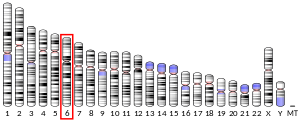Aldehyde dehydrogenase 5 family, member A1
| ALDH5A1 | |||||||||||||||||||||||||||||||||||||||||||||||||||
|---|---|---|---|---|---|---|---|---|---|---|---|---|---|---|---|---|---|---|---|---|---|---|---|---|---|---|---|---|---|---|---|---|---|---|---|---|---|---|---|---|---|---|---|---|---|---|---|---|---|---|---|
 | |||||||||||||||||||||||||||||||||||||||||||||||||||
| |||||||||||||||||||||||||||||||||||||||||||||||||||
| Identifiers | |||||||||||||||||||||||||||||||||||||||||||||||||||
| Aliases | ALDH5A1, SSADH, SSDH, Aldehyde dehydrogenase 5 family, member A1, aldehyde dehydrogenase 5 family member A1 | ||||||||||||||||||||||||||||||||||||||||||||||||||
| External IDs | OMIM: 610045; MGI: 2441982; HomoloGene: 840; GeneCards: ALDH5A1; OMA:ALDH5A1 - orthologs | ||||||||||||||||||||||||||||||||||||||||||||||||||
| |||||||||||||||||||||||||||||||||||||||||||||||||||
| |||||||||||||||||||||||||||||||||||||||||||||||||||
| |||||||||||||||||||||||||||||||||||||||||||||||||||
| |||||||||||||||||||||||||||||||||||||||||||||||||||
| |||||||||||||||||||||||||||||||||||||||||||||||||||
| Wikidata | |||||||||||||||||||||||||||||||||||||||||||||||||||
| |||||||||||||||||||||||||||||||||||||||||||||||||||
Succinate-semialdehyde dehydrogenase, mitochondrial is an enzyme that in humans is encoded by the ALDH5A1 gene.[5][6][7]
Function
This protein belongs to the aldehyde dehydrogenase family of proteins. This gene encodes a mitochondrial NAD+-dependent succinic semialdehyde dehydrogenase. A deficiency of this enzyme, known as 4-hydroxybutyricaciduria, is a rare inborn error in the metabolism of the neurotransmitter γ-aminobutyric acid (GABA). In response to the defect, physiologic fluids from patients accumulate GHB, a compound with numerous neuromodulatory properties. Two transcript variants encoding distinct isoforms have been identified for this gene.[7]
References
- ^ a b c GRCh38: Ensembl release 89: ENSG00000112294 – Ensembl, May 2017
- ^ a b c GRCm38: Ensembl release 89: ENSMUSG00000035936 – Ensembl, May 2017
- ^ "Human PubMed Reference:". National Center for Biotechnology Information, U.S. National Library of Medicine.
- ^ "Mouse PubMed Reference:". National Center for Biotechnology Information, U.S. National Library of Medicine.
- ^ Chambliss KL, Caudle DL, Hinson DD, Moomaw CR, Slaughter CA, Jakobs C, Gibson KM (Jan 1995). "Molecular cloning of the mature NAD(+)-dependent succinic semialdehyde dehydrogenase from rat and human. cDNA isolation, evolutionary homology, and tissue expression". The Journal of Biological Chemistry. 270 (1): 461–7. doi:10.1074/jbc.270.1.461. PMID 7814412.
- ^ Trettel F, Malaspina P, Jodice C, Novelletto A, Slaughter CA, Caudle DL, Hinson DD, Chambliss KL, Gibson KM (May 1997). "Human Succinic Semialdehyde Dehydrogenase". Enzymology and Molecular Biology of Carbonyl Metabolism 6. Advances in Experimental Medicine and Biology. Vol. 414. pp. 253–60. doi:10.1007/978-1-4615-5871-2_29. ISBN 978-1-4613-7692-7. PMID 9059628.
- ^ a b "Entrez Gene: ALDH5A1 aldehyde dehydrogenase 5 family, member A1 (succinate-semialdehyde dehydrogenase)".
External links
- Human ALDH5A1 genome location and ALDH5A1 gene details page in the UCSC Genome Browser.
- Overview of all the structural information available in the PDB for UniProt: P51649 (Succinate-semialdehyde dehydrogenase, mitochondrial) at the PDBe-KB.
Further reading
- Hearl WG, Churchich JE (Sep 1984). "Interactions between 4-aminobutyrate aminotransferase and succinic semialdehyde dehydrogenase, two mitochondrial enzymes". The Journal of Biological Chemistry. 259 (18): 11459–63. doi:10.1016/S0021-9258(18)90883-5. PMID 6470007.
- Chambliss KL, Hinson DD, Trettel F, Malaspina P, Novelletto A, Jakobs C, Gibson KM (Aug 1998). "Two exon-skipping mutations as the molecular basis of succinic semialdehyde dehydrogenase deficiency (4-hydroxybutyric aciduria)". American Journal of Human Genetics. 63 (2): 399–408. doi:10.1086/301964. PMC 1377305. PMID 9683595.
- Hogema BM, Akaboshi S, Taylor M, Salomons GS, Jakobs C, Schutgens RB, Wilcken B, Worthington S, Maropoulos G, Grompe M, Gibson KM (Mar 2001). "Prenatal diagnosis of succinic semialdehyde dehydrogenase deficiency: increased accuracy employing DNA, enzyme, and metabolite analyses". Molecular Genetics and Metabolism. 72 (3): 218–22. doi:10.1006/mgme.2000.3145. PMID 11243727.
- Aoshima T, Kajita M, Sekido Y, Ishiguro Y, Tsuge I, Kimura M, Yamaguchi S, Watanabe K, Shimokata K, Niwa T (2002). "Mutation analysis in a patient with succinic semialdehyde dehydrogenase deficiency: a compound heterozygote with 103-121del and 1460T > A of the ALDH5A1 gene". Human Heredity. 53 (1): 42–4. doi:10.1159/000048603. PMID 11901270. S2CID 25065695.
- Blasi P, Boyl PP, Ledda M, Novelletto A, Gibson KM, Jakobs C, Hogema B, Akaboshi S, Loreni F, Malaspina P (Aug 2002). "Structure of human succinic semialdehyde dehydrogenase gene: identification of promoter region and alternatively processed isoforms". Molecular Genetics and Metabolism. 76 (4): 348–62. doi:10.1016/S1096-7192(02)00105-1. PMID 12208142.
- Novikov VD, Valova TA, Iasakova NT, Belan IB (2003). "[Morphological and functional characteristics of lymphocytes of mothers of children with Down syndrome]". Morfologii͡A. 118 (4): 74–80. PMID 12629812.
- Akaboshi S, Hogema BM, Novelletto A, Malaspina P, Salomons GS, Maropoulos GD, Jakobs C, Grompe M, Gibson KM (Dec 2003). "Mutational spectrum of the succinate semialdehyde dehydrogenase (ALDH5A1) gene and functional analysis of 27 novel disease-causing mutations in patients with SSADH deficiency". Human Mutation. 22 (6): 442–50. doi:10.1002/humu.10288. hdl:2108/48106. PMID 14635103. S2CID 20057400.
- Plomin R, Turic DM, Hill L, Turic DE, Stephens M, Williams J, Owen MJ, O'Donovan MC (Jun 2004). "A functional polymorphism in the succinate-semialdehyde dehydrogenase (aldehyde dehydrogenase 5 family, member A1) gene is associated with cognitive ability". Molecular Psychiatry. 9 (6): 582–6. doi:10.1038/sj.mp.4001441. PMID 14981524.
- Kang JH, Park YB, Huh TL, Lee WH, Choi MS, Kwon OS (Nov 2005). "High-level expression and characterization of the recombinant enzyme, and tissue distribution of human succinic semialdehyde dehydrogenase". Protein Expression and Purification. 44 (1): 16–22. doi:10.1016/j.pep.2005.03.019. PMID 16199352.
- Blasi P, Palmerio F, Aiello A, Rocchi M, Malaspina P, Novelletto A (Jul 2006). "SSADH variation in primates: intra- and interspecific data on a gene with a potential role in human cognitive functions" (PDF). Journal of Molecular Evolution. 63 (1): 54–68. Bibcode:2006JMolE..63...54B. doi:10.1007/s00239-005-0154-8. hdl:2108/32560. PMID 16786440. S2CID 6067628.
- Knerr I, Pearl PL, Bottiglieri T, Snead OC, Jakobs C, Gibson KM (Jun 2007). "Therapeutic concepts in succinate semialdehyde dehydrogenase (SSADH; ALDH5a1) deficiency (gamma-hydroxybutyric aciduria). Hypotheses evolved from 25 years of patient evaluation, studies in Aldh5a1-/- mice and characterization of gamma-hydroxybutyric acid pharmacology". Journal of Inherited Metabolic Disease. 30 (3): 279–94. doi:10.1007/s10545-007-0574-2. PMID 17457693. S2CID 20004337.
 | This article on a gene on human chromosome 6 is a stub. You can help Wikipedia by expanding it. |
- v
- t
- e



















